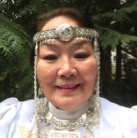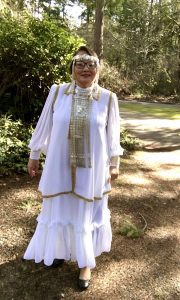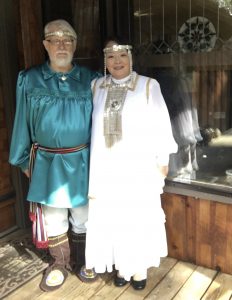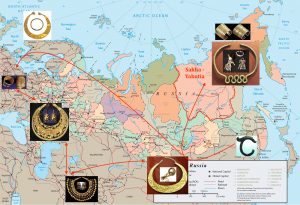
Zoya I. Ivanova
|
Baha’i Zoya I. Ivanova, ScD, geneticist, associate professor, was born near the Arctic Ocean in Republic of Sakha (Yakutia) Russia, grew up and finished school in the coal-mining village Sangar, on the bank of the great Siberian River Lena. She graduated from the Yakut State University (1974) and got PhD from the Institute of General Genetics of the USSR Academy of Sciences, in Moscow (1979) and the second ScD degree in 1997. Zoya I. Ivanova 20 years taught genetics at the Yakut Agricultural Academy and conducted scientific research in the field of immunogenetics of the Yakut native cattle, was engaged in issues of its preservation and study of gene pool at the level of DNA. Zoya I. Ivanova is the author of a number of monographs and scientific articles on Yakut cattle, published in international academic journals. She got information about Baha’i Faith after Perestroyka that happen in Soviet Union in 1992. Her first Baha’i teacher is Inger J. Ellingsen, Ph.D. in Ecology and the oldest professor at Norwegian University – Bodin upper secondary school and Maritime College (Bodo, Norway). She served as a Baha’i pioneer in the Republic of Sakha (Yakutia) for almost a quarter of a century, radiating love to all people and supporting them in the daily life difficulties. Before declared herself Baha’i, Zoya studied the Baha’i Writings, during two years and she met Baha’i from many different countries. In 1995 Zoya declared herself Baha’i. Since than her life became very intense and change dramatically; in 2000, Zoya met her future husband Richard Kendell – Baha’i from America, who came to the Baha’i community of Yakutia (Sakha), as a travel teacher and conquers all, with his kindness, inner harmony and wisdom. The Local Spiritual Assembly of Yakutsk asked Zoya to accompany Richard and his translator Natasha Vasilyeva in their journey to Sangar, the village where Zoya grew up and where she has acquaintances and friends. In Sangar they had many opportunities to talk to people about the Baha’i Faith. They conducted several studies on the book Ruhi 1 and were invited to the annual August conference of teachers from all schools of the district. Richard and Zoya talked openly about the Baha’i Faith and spiritual education to a large audience of teachers. Brilliant Natasha’s translation helped an understanding and Richard had to answer on many questions. After that travel and common service of the Baha’i Faith, Richard and Zoya decided to marry. Their wonderful wedding took place 6 November 2000 in Seattle.
Now Zoya I. Ivanova lives on two continents of the Earth as a citizen of the world, in love with her native Olonkho Land – Republica Sakha and the new Homeland – United State of America. Life in the United States, open the opportunity to publish her mother’s stories about the life of the ancestors. By doing that, Zoya Ivanova clearly realized her responsibility, as a qualified specialist, in explaining the methods of genetics that are used to restore the ancient history of the people, as well as the scientific facts that can help to understand the genetic history of the Sakha people.
She wrote and published in Yakutsk (Russia) two non-fictional books about the genetic history, spirituality and culture of the Sakha people. The same book in English entitled “Sakha ‘s Sarga, Totem Pole and Stone Age Megaliths are from” One Family. The Life of the Yakut Family… Stories of Great-Grandmother – Yevdokiya P. Ivanova” was published in 2015 and now available on Amazon Kindle – the largest book market in the world. According to the rating of the BookAuthority the book occupies one of the best places in between the books about the Neolithic age. CNN, Forbes and Inc identify BookAuthority as the evaluator of the best books in the world. This first book contains the stories told by Zoya’s mother about the life of our Sakha ancestors in the late 19th and early 20th centuries. In order to better understand these stories by foreigners, the author tried to explain the genetic history, the ancient Faith and the culture of Sakha people, based on the data of full-genome studies and the data of own studies of the Yakut native cattle. The second book, entitled “The Progenitor of the Sakha People — ANE – Ancient Northasian Europoid” in Russian language now in print, supposes to be in the market of the capitol city Yakutsk during March 2020. The author is currently busy translating her new book into English. Here is Zoya I. Ivanova explanation of the main reasons she writes the books: Mother’s stories had a strong attraction. We’ve heard them many times; however, every time they surprised us, because they were warmed by Mom’s good sense of humor, love for people and her loving and radiant look. I am sure that Mother’s stories influenced our spiritual development. However, up to now, not one of her children had the right living conditions that permitted them to spend time and write the stories down, to prevent them from being forgotten and lost. I got the blessing to have an opportunity and all the comforts of life in the USA, to save some of Mom’s stories on a recorder — a wonderful gift from my husband Richard Kendell. We have a lovely wooden cabin in the gated community “Clearwood”, near Yelm, WA. It is a very beautiful and peaceful wooded area with three lakes. Often Mom and I went for a walk around the small “Blue” lake or the big “Clear” lake. While Mom was slowly walking and telling me her lovely stories, I was recording them and later I was typing them on my PC and printed them on paper. In 2009 my stepson Glen helped me to save them on several DVDs. So, now all Mom’s children, the grand- and the great grandchildren have the possibility to hear several her stories, saved on DVD. Mother came to visit us, in the USA, twice. The first time, she lived with us in “Clearwood” from August 2002 till January 2003. The second time she visited us from August 2005 till December 2005 mostly in Seattle, because I was working at that time at the “DNA — lab” of the University of Washington. We were renting an apartment in Seattle, but still were able to spend our weekends in “Clearwood”. During the two last years of her life, Richard and I lived near her, in Yakutsk. Mother died on the night of December 14, 2008 in her own apartment, in Yakutsk. She then was 86 years old, by her own words, and according to her Russian passport — 84. We buried mother in the “Magansky” cemetery of Yakutsk, and in April 2009 we returned to the USA. After our return, I was engaged in translating mother’s stories into English, hoping to transfer her loving warmth and kindness living in her stories to the hearts of many people on the planet. This is an almost impossible task, because of my English, however the love to my Homeland and my people, and also the pain kept me going. My pain is generated by long oblivion of my native culture, language and loss of knowledge of the origin and history of my people. This is a result of oppression by powers of an old dying World Order. Thank God, the principle of the Unity of Mankind brought into action powerful forces promising, “soon will the present-day order be rolled up, and a new one spread out in its stead” [Baha’u’llah]. This principle is not “mere outburst of ignorant emotionalism or an expression of vague and pious hope” and it is not “to be merely identified with a reawakening of the spirit of brotherhood and goodwill among men nor does it aim solely at the fostering of harmonious cooperation among individual peoples and nations. Its implications are deeper. <…> concerns itself primarily with the nature of those essential relationships that must bind all the states and nations as members of one human family” [Shogi Effendy]. Therefore, any efforts to enhance the understanding of national cultures aren’t in vain; they are vital for building a spiritual civilization. “The Earth is but one country and mankind its citizens” [Baha’u’llah]. Therefore the time has come, when the representatives of indigenous peoples have opportunities to make more efforts to be open and share the treasures of their national cultures with the rest of the world. Those treasures will increase the efficiency of mankind. The new spiritual civilization, the new united world will be “infinite in the diversity of the national characteristics of its federated units. <…> Diversity of hues, form and shape enricheth and adorneth the garden, and heighteneth the effect thereof” [Shogi Effendy]. I preceded the stories of my mother with two introductions. The first introduction is made on the basis of the review and the analysis of modern molecular genetic researches about the origin of the Sakha people and the second introduction is about the sources of the ancient religion of my people — Aar Aiyy Tangara – the northern branch of Tengriism. All the events of mother’s stories occurred in our homeland — the Sakha Republic (Yakutia), its vast territory on the world maps, looks like a big white spot. Unfortunately, this white spot acts as a symbol not only of the low population density, but also of lack of information to the world about the land of Olonkho[i] and its people. The Sakha Republic (Yakutia) is located in the Northeast of the Russian Federation. It is the largest administrative-territorial unit in the world and, correspondingly, the largest subject of the Russian Federation. I wrote two introductions in which I decided to state my point of view on the origin of the Sakha people and the sources of their religion “Aar Aiyy Tangara”. For that there are three reasons: The first reason is my idea that the best way to explain the culture of my people is through the process of joint research on the origin of the people and sources of their religion. The second reason is that there is no scientifically proven theory about the origin of the Sakha nation and their religion. It is still something of a mystery. Also the traditional Sakha religion “Aar Aiyy” is not well known, because for 316 years Russian officials and the Orthodox Church had prohibited it. However, it is still in practice in daily life of many Sakha families. I feel I have the right to express my point of view on an equal basis with other people’s hypotheses, until the true scientific theory about the origin of the people of Sakha and its religions will be developed. The third reason is connected with an aspiration to overcome my own “mankurtism”[ii] loss of connection with my own roots. Since my early childhood, the only impact on the formation of our points of views about sources of spiritual and material culture of the Sakha people was my mother’s stories. Their influence was crystal-clear, in the midst of the total absence of the slightest information on the existence of history and culture of the Sakha people, in Soviet schools and universities textbooks and training programs. Life forced me to realize the damage caused by this dense ignorance on formation of a positive mentality, career and, as a whole, vital well-being. The more I realize my own “mankurtism”, the more I am convinced that nobody, except ourselves, representatives of oppressed indigenous peoples, can rescue the world from this ignorance and the damage caused by it. I hope that these two introductions will serve as a contribution to overcoming our compelled “mankurtism”, especially for the young generations of indigenous peoples. So that they may be raised more harmoniously, live more joyfully and happily than us, by understanding that they are part of the common history of mankind and the contribution of their ancestors to development of the world civilization is worthy of recognition by all the peoples of the Earth. Therefore, even though I am not an expert in these fields and I can not avoid subjectivity, I risked to state my point of view on the sources of the spiritual and material culture of the Sakha nation, hoping to facilitate the reader’s interest to the atmosphere of the life of the people of Sakha at the end of the 19th and at the beginning of the 20th centuries which is alive in mother’s stories. English is not my native language and only 19 years ago, fist time in my life, I heard the informal conversation in English and was not able to catch even separate words. I would ask the readers to, please, forgive my errors.” Here the link to my book in Amazon: Zoya’s new book has just been printed, “Progenitor of the Sakha people – ANE – Ancient Northasian Europoid” touching the pain points of Eurocentric interpretations of the scientific facts, aims racism, fights for the unity of all mankind. In my book I try to formulate the concept of “genetic vortex,” both as ancient territory and the ancient society, located on the paths of early migrations of the common ancestor of the mankind from Africa. I cite genetic data that indicate in ancient Asia, the regions of my Homeland – Sakha, the Altai and the Lake Baikal as such socio-territories since Paleolithic times. I tried to explain, in the accessible language, the methods that geneticist use to prove it. These vivid “genetic vortexes,” in my opinion, are similar to the Holy Places in the Earth, which from ancient times to the present act both as the centers of people attraction and the centers of dispersion of spiritual Teachings, such as the Temple of Bab on Mount Carmel (Haifa, Israel). They remind me of an eternal circle in the struggle for survival, as well as in the pursuit to the enlightenment and education of my Sakha people It is no accident that the Hand of the Cause of God – Amatu’l-Bahá Rúhíyyih Khánum wrote that the potential of humanity can be disclosed only when the indigenous people will take a leading position not only to promote the Cause of God, but also in society matters, in a broad sense and everywhere. She wrought how to overcome injustice and satanic things that white people have done, all their wars, cruelty, their lies, deceit, speculation, immorality and shamelessness. She cites the words of the Guardian of the Bahá’í Faith, Shoghi Effendi: “It is a great mistake to believe that because people are illiterate or live primitive lives, they are lacking in either intelligence or sensibility .0n the contrary, they may well look on us, with the evils of our civilization, with its moral corruption, its ruinous wars, its hypocrisy and conceit, as people who merit watching with both suspicion and contempt. We should meet them as equals, well-wishers, people who admire and respect their ancient descent, and who feel that they will be interested, as we are, in a living religion and not in the dead forms of present-day churches.” The validity of these great words of the Baha’i leaders that indigenous peoples themselves should carefully study there own history, “filtering” and carefully rechecking Eurocentric interpretation of the scientific data, I can attest to the experience of my own life, which began on the shores of the Arctic Ocean, and then continued in mining town Sangar, right by the great expanse of the Lena river, then at the university and academic centers of Yakutsk, Moscow, Novosibirsk and Seattle. From the little barefoot Sakha girl, running on the coal dumps of the former gulag, to research scientist working on the super-modern genetic analyzer at the University of Washington. Indigenous peoples, in fact, must rise to educate themselves and get the best education, to rediscovery the trues about their own history, their dignity and serve the betterment of the world, as well as the healing of indigenous peoples from the effects of the discrimination and racism. The recent genome-wide study of the international teams of the paleogeneticists almost cleared those curtain that prevented me to see a more accurate picture of the genetic history of the Sakha people from the Paleolithic to the Iron Age. The name of my new book is “Progenitor of the Sakha people – ANE – Ancient Northasian Europoid”. The abbreviation ANE is used as the name of an ancestral component related genetic line of mammoth hunters from the archeological culture Mal’ta-Buret’ near Lake Baikal of North Asia. Paleogenetics decipher abbreviation ANE bit different than me; they call the ancestral genetic component of all people living in Eurasia – Ancient North Eurasian or ancient northern Eurasian. I reinterpret this abbreviation “ANE” as Ancient Northasian Europoid” not by accident. The scientific fact that Paleolithic and Mesolithic Europeans have no relation to Paleolithic hunters on the mammoths, living on Baikal’s archaeological site Mal’ta-Buret’ “induced” it to me to do. Europeans did not cross throughout of Eurasia in the Paleolithic time from the west to the east and did not discover America, according to claims of the Eurocentric Solutrean hypothesis. Recent full-genomic research hammered the last nail into “coffin” of this hypothesis. Modern Europeans received so-called “European-like” features from northern Asians when riders-nomads of the Eurasian steppes began to expand to Europe since the Neolithic era and in a Bronze Age replaced with their genetic lines 90% Paleolithic gene pool of Britain and 50% of the Central Europe. Relying on full-genomic researches of ancient DNA, across all Northern, East, Southern Asia, and also Glacial and Neolithic Europe, I justify the origin of the Sakha people, all Eurasians and native American peoples from a common protomorphic[1] North Asian Ancestor who lived in Altay, Lena River’s and Baikalia’s valleys, since a Paleolithic time. In my book I give my own definition to the terms “Mongoloid” and “Europeoid. The book offers a non-racial vision of the ethnogenesis of all people in the Earth. My hypothesis lean mainly on the recent 2015-2019 paleo-DNA researches and I include to my new book the second part of my mother’s stories and they are from time around WWII. Also I included some stories from my childhood. Right now I am translating my new book in English language. Thank you for your interest! [1] Protomorphic or ancient people (Homo sapience sapience) that have intermediate features in-between “European-like” and “Mongoloid-like” [i] The Olonkho (Russian: олонхо, Yakut: олоҥхо) is a heroic epic tale of the Sakha and one of the oldest epic arts of the Turkic peoples. The term refers to the entire Sakha epic tradition as well as its central epic. [ii] The term “Mankurt” refers to a person who cannot recall his or her cultural roots and origin. The word comes from a Turkic myth popularized by Chinghiz Aitmatov in his novel The Day Lasts More Than a Hundred Years (“И дольше века длится день”). It is a philosophical tale about what can happen to people if they forget their motherland, language, and history. The Turkic legend mentioned in the novel tells about a cruel way of making a mankurt of a captive man obtaining that he forgets everything but basic activities and, thus, becomes an ideal slave of Djungar masters. The process involves a round of fresh rawhide from the neck of a camel, that would be planted as a sort of cap on the thoroughly shaven head of a captive. His hands as well his feet are tied and to prevent the victim to replace the cap by rubbing his head on the ground a large wooden stock is installed around his neck. That captive would be then simply left in desert for several days. Once the hide would start drying it would shrink and bind to the head, thus making a hoop and literally “squeezing” all sanity out of the man (usually). What is worse, the hair is not always able to grow through the camel’s hide so it often curls back and would penetrate the scalp causing a pain beyond endurance. Usually that victim would perish from such a torture or a thirst. If the man happens to survive the torture, he would be recuperated and become like a dog to his master, not remembering anything. “Mankurt” is captured, tortured, and brainwashed into serving his homeland’s conquerors. He is so completely turned that he kills his mother when she attempts to rescue him from captivity [7]. |

 Zoya I. Ivanova -scholar and author
Zoya I. Ivanova -scholar and author


